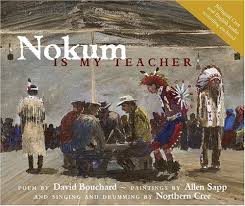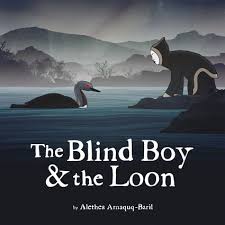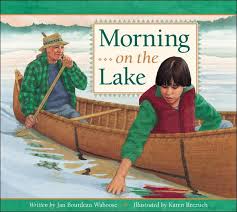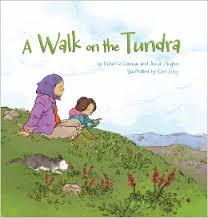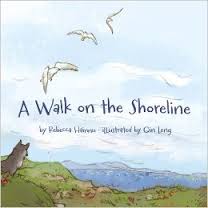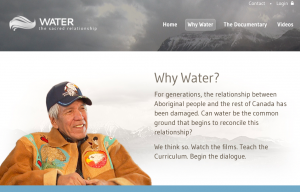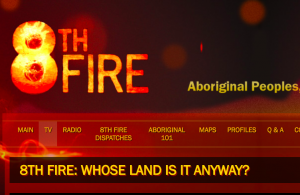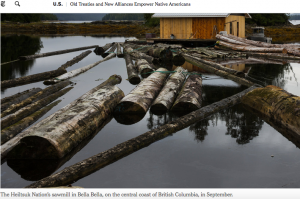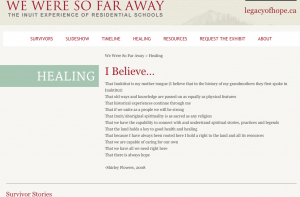- One of the sources I looked at was a document put out by the United Nations and discusses the ecological effects of climate change on Indigenous Peoples around the world. While this doesn’t directly relate to my paper topic, I found it an interesting read to see how drastically these cultures are affected. In seeing how affected these cultures are, you can also see their connection and dependence on the land, something that is often “overlooked” in the modern world http://www.un.org/en/events/indigenousday/pdf/Backgrounder_ClimateChange_FINAL.pdf
- The second source I looked at was directly related to my final research topic. https://www.ischool.utexas.edu/~vlibrary/edres/pathfinders/ajohnson/pathfinder.html It is called “A New Understanding of Culture and Communication: The Impact of Technology on Indigenous Peoples” by AJ Johnson. I found this to be a helpful source as it ask some of the key questions surrounding the preservation of Indigenous culture through technology and provides links to sites that attempt to provide an answer.
- This was another source that directly relates to the preservation of culture through technology. Its called DiPLO and discusses some of the initiatives being undertaken to use technology constructively and positively in Indigenous Cultures around the world. “Although current trends show that modern technology can put certain cultures at risk, the same technology can be used to solve the problem. In fact, strategic use of the tools at our disposal will not only help to preserve less-represented cultures, but also help promote them to the entire world.”
- Another source I looked at tied the theme for this module together with my paper topic. It is called Muiniskw Spirit. It tells the story of “THE LEGACY OF MUIN’ISKW – TRADITIONAL ECOLOGICAL KNOWLEDGE.” It is written from the perspective of an Indigenous individual and discusses how “many have found that indigenous philosophies offer some of the most profound insights for cultivating the kind of sustainable relationship we need with the Earth, and the spiritually integrated perception of Nature needed to address what has now become a global crisis of the ecology.” I question the authenticity of this source as it doesn’t explicitly state the credentials of the authors. In reading through this site it made me think of the article we read in Discussion #6 about Blue Snake, an individual masquerading as an Indigenous individual. That being said though, this has the potential to be a great example of how Indigenous cultures can use technology to preserve and share their traditional knowledge.
- The last source I looked at was called AMN (Aboriginal Mapping Network). This source shows how technology can be used to map traditional knowledge. “Digital cartography offers exciting opportunities for recording indigenous knowledge, particularly in contexts where a people’s relationship to the land has high cultural significance.”
Category Archives: Archive
The Journey Continues
I have found that my research gets specific, then general again and so on, in a cycle. Here is a mix of resources that reflect both the general and specific of my iterative research. I had a brief conversation with my vice-principal this week about this course and the research that I hope to continue through to the end of this year, hopefully next. In that meeting, I commented on how much I have learned this term, just enough to know how little I actually know! Here’s to the continued journey.
Grande, S. (2008). Red pedagogy: The un-methodology. In N. Denzin, Y. Lincoln, & L. T.
Smith (Eds.), Handbook of critical and Indigenous methodologies, (pp. 233 – 254).
Thousand Oaks, CA: SAGE Publications.
Though there are a few pages missing in this google book version, the noble vision of this chapter is evident. Grande (2008) calls attention to the reality that Indigenous scholars and theorists have been focused on social issues in their communities and critical pedagogies have been overlooked. His chapter almost reads as a challenge to indigenous educators, as if he is daring you to grab hold of red pedagogy and see what happens.
McMullen, B. and Rohrback, A. (2003). Distance education in remote Aboriginal communities: Barriers, learning styles and best practices. Prince George, BC: College of New Caledonia Press.
I was absolutely elated to find this. I have been very impressed with McMullen on a professional level and was thrilled to see that he co-authored a book a few years back. A book that has a poignantly relevant topic. It is one of the few resources that I printed off. I hope it will be good enough to snuggle up with next to the fire this weekend, but I only found it today so can’t speak to it yet.
Gooyers, B. (n.d.) Aboriginal Portal: Providing information and instruction to aboriginal distance students.
A simple guide for librarians in supporting Aboriginal distance students and a great reminder to instructional designers to not forget about their librarian or other student support services when designing a course.
C Pappas. (2014, November 26). The quintessential of the sociocultural learning theory. Retrieved from https://elearningindustry.com/sociocultural-learning-theory
An excellent reminder of the basics of Vygotsky’s theories. We so often apply his theory to early childhood education, forgetting that school aged children and adults are daily faced with learning new cultures and mindsets.
Indigenous and Northern Affairs Canada. (2015). Success stories.
I thought it appropriate to end on a positive note and provide a place where we can all go for inspiration.
Web Research Post 4 – Aboriginal Film
This collection of websites all again connect with First Nation Film but I have some that have lesson plans attached to them.
#1 How People Got Fire
https://www.nfb.ca/film/how_people_got_fire/ (the film)
http://www.yesnet.yk.ca/firstnations/pdf/hpgf_guide.pdf (teacher’s guide)
This is a short animation that illustrates the connection between youth and elders. It is a beautiful animation, with very stylized illustrations. There are two different types of illustrations used – one that shows the relationship between the youth and elders and the other is the oral telling of the myth How People got Fire. The manner in which the story is told is quite unique and would expose students to another narrative style. I also found a study guide to go with the animation. It provides a lot of background information, as well as ways the short can be incorporated into the classroom.
#2 Documentary “We Will be Free” Aboriginal People in Canada (1 hour)
https://www.youtube.com/watch?v=OXT2JXe8mnA
I found this documentary online and thought it was quite informative. The documentary is about an hour in length and provides insight and understanding into the treatment and struggles faced by Aboriginal people today. It focuses on Aboriginal people in Winnipeg specifically but I think that much of the information would apply to other areas of the country. I don’t know if I would use the documentary with a class; there is some inappropriate language but it’s quite minor. I just think that some of the issues discussed could be difficult for a class – it would depend on the level of the students. The documentary doesn’t sugar-coat anything but speaks of the feelings people face and what is being done to improve life for First Nations people.
#3 The World Anew
http://www.cineworks.ca/theworldanew/
This website was really interesting! It houses and explores contemporary Frist Nations film. The site is connected to the British Columbia Arts Council and the City of Vancouver. It has a lot of information about specific First Nations film makers. There are some films featured on the site but it provides biographs and interviews with different Frist Nation film makers from Canada. The Resources section is quite detailed as well. It provides links to organization and activities “that help Aboriginal youth to get involved in filmmaking”. I would think that this would be a great resource for teachers in BC to help promote filmmaking in classes. Please note though that some of the resources links are expired so you will want to preview them to make sure they work before sharing them with a class. The films shared on the site are good quality and there are a variety of types; some are animations and others are not. They range in length from short films to feature length films. There also isn’t any problem streaming the films online.
#4 OSIE – Deepening Knowledge: Resources for and about Aboriginal Education
I stumbled upon this site and found it really interesting. There are a lot of resources that can be used by teachers. I found some of the downloadables really helpful for my class and it was nice that they could be changed and tailored to my individual classes. I particularly liked the handout “Criteria for Identifying Bias” in the Teachers Resource: Best Practices in including Aboriginal Peoples in the Curriculum. They prove a lot of teacher resources as well as student resources to use. I found that the content was appropriate for both grade school and high school. It needs to be noted that the information connects to the FNMI Curriculum for Ontario but I’m sure that many of the resources provided could be useful anywhere.
#5 Indigenous Feature Film Production in Canada: A National and International Perspective
Here is another site I just happened upon this resource when I was looking at the imagineNATIVE Film and Media Arts Festival. The study examined Aboriginal film production in Canada. I haven’t had an opportunity to read through the whole report yet (it’s 50+ pages) but the report examines the allocation of public funding for films in Canada as well as the barriers to film production for Aboriginal film makers. The document will tie in nicely with my other research about First Nations film making.
Stories and Place
Nokum is My Teacher – David Bouchard
“to watch you learn to see” ~ Nokum’s words to grandson in response to getting an “education”
David Bouchard, a Canadian Metis born and raised in Saskatchewan, is a writer of over 50 books. This particular picture book includes both English and Cree languages and is a dialogue between a boy and his grandmother, or Nokum. Due to its powerful message regarding the intersection of indigenous peoples and western education, this story is a must read for all western educators.
To watch an excellent production of this book through video, click here: Nokum is My Teacher
Inhabit Media
While previewing The Blind Boy and the Loon by Althea Arnaquq-Baril, I was introduced to Inhabit Media as mentioned in the commentary within the book. Inhabit Media is a publishing company purposed in promoting and preserving Inuit voice, story and art through book publications for both children and adults. An extensive book reference page of their published children’s books is a valuable resource for the elementary educator.
Unnikkaat Studios Inc.
Althea Arnaquq-Baril, recognizing the need to preserve the language of her people, built her company, Unnikkaat Studios Inc., to produce Inuktitut documentaries and language productions. As the Inuit are traditionally an oral culture, using a means of oral documentation of stories and history through film making can be an effective and productive way of both preserving the voices of the Inuit and allowing their voices to be shared with others.
Morning on the Lake – Jan Boudreau Waboose
A beautiful depiction of place as told through the words of Jan Boudreau Waboose, a Nishwabe Ojibway from northern Ontario. Place-based references to landscape, animals, sky and environment are seamlessly interwoven throughout the text.
Rebecca Hainnu
Rebecca Hainnu is an elementary school teacher in Nunavut, a curriculum writer, and a picture book author. Particularly, A Walk on the Shoreline and A Walk on the Tundra encompass place-based knowledge. Her newest book extends plant knowledge and is entitled, Walking with Aalasi: An Introduction to Edible and Medicinal Arctic Plants.
MODULE 4
This site embodies the sacredness of water and the need to restore the balance that was lost because newcomers overlooked traditional knowledge and teachings about the importance of water, land, and the environment. It seeks to restore “water ethics,” traditional knowledge, and knowledge keepers. The documentary argues for returning to the Elders’ teachings that follow the importance of taking care of the environment. Respecting everything in the environment, the trees, the birds, all the animals and the water will leave a good legacy for seven generations to come.
2. http://www.cbc.ca/8thfire//2011/11/whose-land-is-it-anyway.html
8th Fire tells the story of Aboriginal peoples; it “draws from an Anishinaabe prophecy that declares now is the time for Aboriginal peoples and the settler community to come together and build the ‘8TH Fire’ of justice and harmony.” http://www.cbc.ca/8thfire/index.html It shows the different ways that Aboriginal people are using the land to forge economic relationships to sustain their communities. There are many features in this site like an interactive map that outlines treaties and land claims in Canada. It examines the relationship between Aboriginal and non-Aboriginal peoples in Canada.There are videos like Aboriginal 101 and many others that tackle different issues around the interactions of Aboriginal and non-Aboriginal Canadians. The hyperlinks are great for finding out about Aboriginal people who are movers and shakers in their communities like Clarence Louie, Osoyoos Indian Band Chief and entrepreneur, inducted into the Aboriginal Business Hall of Fame.
This New York Times article discusses the initiatives and solidarities of Indigenous peoples across North America from the Heiltsuk Nation in Bella Bella British Columbia to the people of the Lummi Nation in Seattle. They use protest and sit-ins to lobby governments for the rights to manage their land and fishery resources. They use their voices to express concern about the effects of climate change on the coastal and forest areas where they live. The positive result of this collaboration is the agreement between twenty-seven First Nations group including the Heiltsuk to manage The Great Bear rainforest region in British Columbia area and protect it from commercial activities. Good news that will have long-term positive effects on how Indigenous lands will be used in North America in the future. “The University of Victoria law school in British Columbia will begin enrolling students next year in a degree program that will combine the traditional study of court precedents and legislation with the study of tribal law.”
4. https://fncaringsociety.com/shannens-dream
Shannen’s dream speaks well to the hope and resilience of First Nations youth. It is about the work of a teenage girl who was motivated to work towards the establishment of schools that provided safe and nurturing environments for Aboriginal children. She advocated for schools that would receive adequate funding so that Aboriginal children could attend school holding on their dignity and culture. Shannen died before she could her dream come to fruition, but her legacy has lived on, and the day she would have graduated from high school construction began on a new First Nation school.
The long awaited First Nations school was opened at the end of August 2014. Shannen’s dream website has many useful resource and links on issues re First Nation education.
We were so far away, examines residential schools from the perspectives of the Inuit peoples from the Nunavut, Nunavik, Nunatsiavut and the Inuvialuit Settlement Region. It takes a before, during and after look at the lives of the Inuit who attended residential schools. There are videos of residential school survivors talking about their experiences and links to many other resourceful websites. The pictures in the slideshow are worth a thousand words. Some of it made me think of the story of the residential school in the book Fatty legs by Christy Jordan-Fenton and Margaret Pokiak-Fenton.
Moving toward a future of reconciliation and respect
1. I found this website interesting from the perspective of an educator who would like to give students in the classroom an overview of the First Peoples of Canada. This virtual exhibition provides information about the different societies, languages and population percentages and distribution in Canada, before moving to “An Aboriginal Presence” which gives a short biography on many notable Canadian Indigenous peoples, including Alwyn Morris, a gold and bronze Olympic medalist, and Buffy Sainte-Marie, who co-wrote a song I loved when I was younger titled, “Up Where We Belong” among many others. Included in the virtual exhibition are traditional knowledges and artifacts, as well as origins and archaeology. While the exhibition provides more information than an educator might want to show students (it takes quite a while to read through all of the materials presented) I think it has the potential to be a valuable resource in the classroom. I personally enjoyed the sections “An Aboriginal Presence” (as it gave brief biographies of notable First Peoples) and “We Are the Land” (both knowledge and experience) the most.
First Peoples of Canada [virtual exhibition]. (n.d.). Canadian Museum of History. Retrieved 9 November, 2016, from: http://www.historymuseum.ca/cmc/exhibitions/aborig/fp/fpint01e.shtml
2. The next link is to the “Anishnawbe Health Toronto” website. I am including this website because during a previous weblog entry (Module 2 Weblog, link #3), I found an article by O’Sullivan (2013) titled, “Considering Culture in Aboriginal Care” (link: http://m.cmaj.ca/content/185/1/E27.full.pdf). O’Sullivan’s article highlighted the difficulties encountered by Indigenous patients in the Canadian health care system including a lack of feeling of safety, acceptance, empathy and respect. In contrast, Anishnawbe Heath Toronto appears to do the opposite by providing a community health centre based on traditional Indigenous knowledges and traditions; “AHT offers access to health care practitioners from many disciplines including Traditional Healers, Elders and Medicine People. Ancient ceremonies and traditions, intrinsic to our health care model are available.” The “Overview & History” page shares that Anishnawbe Health Resources was founded in 1984, based on the vision of Elder Joe Sylvester. What originally began as a diabetes project, expanded to encompass the needs of Aboriginal health care in Toronto using a model that is based on culture and traditions. Today the mission of Anishnawbe Health Toronto is “To improve the health and well-being of Aboriginal People in spirit, mind, emotion and body by providing Traditional Healing within a multi-disciplinary health care model.” I feel this is an important resource because it demonstrates for me how traditional Indigenous cultures, traditions, and knowledges can be integrated with the theories of western medicine to provide for the health and well-being of the Indigenous peoples of Canada. It emphasizes for me the fact that we need to integrate Indigenous knowledges into all aspects of Canadian society, not simply into our classrooms.
Anishnawbe Health Toronto. (2011). Retrieved 12 November, 2016, from: http://www.aht.ca/
*Citation for previous article as listed on Weblog entry for Module 2:
O’Sullivan, B. (2013). Considering culture in Aboriginal care. CMAJ, 185(1). Retrieved 10 October, 2016, from: http://m.cmaj.ca/content/185/1/E27.full.pdf
3. The following link is to a powerful, but often extremely painful selection of stories from survivors of residential schools in Canada. Each of the forty-seven stories on the site is told in the form of an interview. Each survivor has his or her own story, but there are common threads throughout many stories that include feelings of community and safety before they were taken away from their families to residential schools, fear and a lack of understanding when being taken to and arriving at residential schools, and of devastating trauma caused by the many different forms of abuse suffered while at residential schools. Each story demonstrates the profound impact of residential schools on Indigenous peoples and their families, and the continued impact on their lives today. Please note before you watch any of these videos that there is a warning on the “Stories” home page due to the painful and disturbing subject matter in many of the videos. A contact number is provided on the home page for the Health Canada 24-Hour National Survivors Crisis Line if needed.
Residential School Survivor Stories. (n.d.). Legacy of Hope Foundation. Retrieved 10 November, 2016, from: http://wherearethechildren.ca/en/stories/
4. The following link is to a CBC News, “As It Happens”, written article and audio episode reporting on the Truth and Reconciliation Commission summary report. The written summary provides information about the report and appeals for “a nation-wide commitment to reconciliation” as it exposes the abuse, deaths and continuing trauma suffered by those who were taken from their homes and forced to attend residential schools. The article includes a summary of key recommendations from the 381-page report. The audio is accessible by clicking on ‘Reconciliation is not an aboriginal problem, it is a Canadian problem. It involves all of us’ on the left side of the screen. In doing this, you will be able to listen to the entire “Truth and Reconciliation Commission summary report coverage” portion of the June 2, 2015 episode of “As It Happens” which is 15 minutes and 51 seconds in length. The episode includes much of the information given in the written article, as well as providing some of the testimonies from Residential School Survivors during the Truth and Reconciliation Commission.
Off, C. and Douglas, J. (2015, June 2). Truth and Reconciliation Commission summary report coverage. As It Happens. Retrieved 9 November, 2016, from: http://www.cbc.ca/radio/asithappens/as-it-happens-tuesday-edition-1.3096950/reconciliation-is-not-an-aboriginal-problem-it-is-a-canadian-problem-it-involves-all-of-us-1.3097253
5. My final link is to a TEDx video titled “Changing the way we see Native Americans” that I found created hope. I was immediately drawn to this TEDx TeachersCollege talk by the opening video of a young Indigenous child watching video images of Indigenous peoples as they are portrayed by Hollywood and other major media sources. When Matika Wilbur began to talk, I was drawn to her message as well as the good and beauty that seemed to emanate from her. Her TEDx talk centered on the modern and mainstream view of Native Americans, based on stereotypical images that are created through major media sources. Her goal is to change the way that Native Americans are perceived. With this in mind, she created a project in 2013 called Project 562 which “seeks to photograph every Federally recognized tribe in the United States and reveal in a brilliant spectrum of art, media, and curricula, the rich and complex twenty-first century image and reality of contemporary Native Americans.” During her talk, Matika Wilbur questions, “How can we expect mainstream support for sovereignty, self-determination, nation-building, tribally-controlled education, health care and jobs, when 90% of Americans only view people, my people, as one dimensional stereotypes situated in the historic past, or even worse situated in their imaginations. I argue that we can’t.” (time stamp: 11:38). Matika seeks to create positive change by identifying contemporary Indigenous role models, and to connect us together so that we can learn to respect and honour one another.
Wilbur, M. (2014). Changing the way we see Native Americans [online video]. TEDx TeachersCollege. Retrieved 10 November, 2016, from: https://www.youtube.com/watch?v=GIzYzz3rEZU
Literacy Resources …
- Incorporating digital media into our classrooms can help Aboriginal Legends come to life. Using a QR code, teachers can help to safely guide students to specific stories and legends without lengthy web searches. Using a QR code reader, such as Qrafter, scan the below bar code. You will be immediately directed to open up the URL and there will be Grandmother Spider Brings The Sun. This is the narration of the book by the same name by Navajo author Geri Kearns. ( You can get to it through this link too, but have fun and try the code!)
 https://www.youtube.com/watch?v=ok_b46A9hvE
https://www.youtube.com/watch?v=ok_b46A9hvE
2. http://honeyant.com.au/aboriginal-education/
This was an interesting website to come upon. Please take the opportunity on the site to listen to this interview by Margaret James. She talks about children coming into school with Aboriginal English, which is what I have been writing about in my paper; we call it English as a Second Dialect here in BC (ESD). She emphasizes that students need to learn to read in their first language, then will transfer the skills. These books will be not focusing on the gender or pluralizing of words. I am curious to get my hands on one to take a look.
3. https://www.youtube.com/watch?v=HbccTPEgBhs
I am so pleased to have found the work of Dr. Pamela Rose Toulouse. This video is called How Can Literacy Be Fostered in Aboriginal Kids? She reveals the research that no matter the mother language of the student, English or French will be their second dialect. The child has picked up nuances embedded in their language and bring these to the classroom. These differences need to be valued, even if standard English is the goal. This can be confusing for the child when taught with an emphasis on gender, punctuation etc. The students really have to be “bi-dialectical”, that is having the ability to function in 2 worlds. A variety of resources and exemplars in the classroom will help to create a positive learning environment.
http://elevatorstrategy.com/blog/2015/20-awesome-aboriginal-twitter-accounts-to-follow/
If you want to get connected on Twitter and become more informed about the issues of importance for Aboriginal people, check out this link. You can follow groups such as @Reconciliation Canada or @IENearth, a group of Indigenous people fighting for environmental justice or follow individuals such as @UrbanNativeGirl, From the Tsilhqot’in Nation, Lisa Charleyboy is the Editor for Urban Native Magazine. She’s a well known thought leader in the Aboriginal community and keeps up to date on events and news.
5. Indigenous Education in Canada PSA. In the below video,a 17 year old Indigenous youth in Nunavut talks about her history. She reflects on 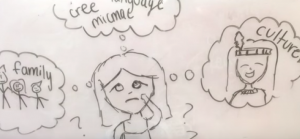 the 51% drop out rate and the importance of heritage and culture being taught in the schools as part of change. Encouraging more Aboriginal People to go into the field of education would support our children in their schools. Relationships between educators and Aboriginal Peoples must be strengthened as language and culture comes into the classroom, with an emphasis on the importance of this for all students. https://www.youtube.com/watch?v=ZrUw1WYfZXc
the 51% drop out rate and the importance of heritage and culture being taught in the schools as part of change. Encouraging more Aboriginal People to go into the field of education would support our children in their schools. Relationships between educators and Aboriginal Peoples must be strengthened as language and culture comes into the classroom, with an emphasis on the importance of this for all students. https://www.youtube.com/watch?v=ZrUw1WYfZXc
Weblog Module 1
Module 1 Weblog
- http://www.trc.ca/websites/trcinstitution/index.php?p=813
- An excellent place to start to understand the generational torture that aboriginals endured under the residential school system. One of the areas that I look at is under a reconciliation tab. I head to the one that involves the media. As a Film & TV educator, this is my jam.
- http://www.cbc.ca/news/canada/a-history-of-residential-schools-in-canada-1.702280
- The CBC has established an in-depth resource of the history of the Residential School system in Canada. The collection includes an historical time-line, an archive of news items, FAQs and much more. It’s from here that I get a bit of refresher of the history of residential schools and their impact.
- http://www.cbc.ca/archives/entry/its-debatable-native-rights
- From here I look into the CBC archives. It is hard to find the category relating to native issues, it is buried in lifestyle section. One radio clip that catches my eye, “It’s Debatable – Native Rights?”. Having a listen, it is a snapshot into the racism that exists in 1967. The clip is of panel interview with 2 high school students debating with Marlene Castellano, a university-educated native woman who later became a university professor.
- https://www.youtube.com/watch?v=hEJ0o2F7fGo
- Audio only goes so far. So I travel to do some video research on Dr. Marlene Castellano and find her speaking speaking at the Symposium on Reconciliation in Ontario in Toronto, February, 2011. The camera work is shoddy and it is broken up into 5-5 mintue clips. I almost dismissed it as there was other, longer videos of Dr. Castellano speaking but as I was about to move on I heard her get emotional when about talking about her feelings towards the treatment of the Mohawk peoples.
- http://fngovernance.org/publication_docs/reconciliation-report-final_0311.pdf
- A link on the video sends me to a pdf document titled, Symposium on RECONCILIATION IN ONTARIO Opportunities & Next Steps Report on Proceedings. I don’t read the entire thing, but one part that caught my eye discusses this report.
This report is a call to action. It is a compilation of the many ideas, issues, opportunities, next steps and actions identified by event participants. Participants suggested dozens of ways for Ontario’s (and Canada’s) First Nations, citizens, youth, communities, industry, educators and governments to begin the process of reconciliation.
Love it. I will use this document as a reference for the rest of the term.
5 links on language and indigenous ways of teaching
Toward a First Nations Cross-Cultural Science and Technology Curriculum. Retrieved from http://www.duluth.umn.edu/~kzak/documents/Aikenhead97-NOS.pdf
This is an interesting article that discusses the contrasts between indigenous and western views on nature and science. It gives examples of cultural border crossing when western-style teachers work with indigenous students. In many instances, the difference in culture either creates misunderstandings or can blur the original view of the indigenous learners with a new mechanical perspective that does not fit their cultural background.
TVO Agenda – The Future of Aboriginal Education: Language. Retrieved from https://www.youtube.com/watch?v=rrj-eM5KDD8
In this video clip, 25 year old Ryan DeCaire of Wáhta Mohawk Territory gives his view on the importance of encouraging indigenous youth in learning their traditional languages. He welcomes the audience in Mohawk language and explains that many more youngsters are being born in their traditional languages now. He says that in his community, there is a large gap between the age of the youth and older people who speak the indigenous language. This clip shows me the interest and also the affordability of youth in revitalizing their language, as opposed to the generation before them who were victims of the residential schools.
In Their Own Words. The fight to preserve the Cree language. Retrieved from https://thewalrus.ca/in-their-own-words/
This article writes about the fight to preserve the Cree language in the Onion Lake community, especially in the Kihew Waciston school. The teachers of this school are native Cree-speakers and the school curriculum emphasizes the land-based education. Students learn language art, math and science, along with skills such as building campfires and plucking geese. The article gives an overview of the history of the Cree language and its survival, as well as an interesting short explanation of the organization of the language itself.
First Nations Pedagogy Online. Retrieved from http://www.firstnationspedagogy.ca/index.html
This website provides online resources to support best practices for learning initiatives intended for indigenous students, instructors, and curriculum developers. It involves many resources such as videos, explanations and online activities that would support the organization of indigenous-based teachings. The site gives helpful explanations on the pre-colonial ways of teaching and how to incorporate them into today’s teaching.
Four Directions Teachings. Retrieved from http://www.fourdirectionsteachings.com/index.html
This is an interactive website which offers a learning experience about indigenous knowledge and ways of learning through audio-narrated and pictures. It is done beautifully and it offers learners the perspectives of five different indigenous peoples’ teachings in Canada: Blackfoot, Cree, Ojibwe Teaching, Mohawk and Mi’kmaq. The site also offers learning activities that can be incorporated into teachings. It’s a great teaching and learning resource for anyone!
Being Informed About First Nations Social Issues
On November 3, I had the fortunate experience to take a group of students to We Day, where National Chief, Perry Bellegarde presented. 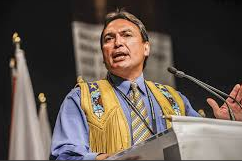 The main issues that he wants to address as National Chief, includes the preservation of First Nations’ languages, education, treaty rights and economic prosperity. As an educational mentor to more than 70 leadership students at my school, I feel that it is important to learn with my students Aboriginal social issues, and come up with strategies in how we can help make changes to better the conditions. Before I lead my students to make change to help others with the healing process, however, I need to first educate myself. I’m starting off with a very basic question: What are the social issues that are endured by First Nations communities? The posts that I am entering for this blog that I am completing for this module will help lead me towards the road to discovery in finding the answers to my question.
The main issues that he wants to address as National Chief, includes the preservation of First Nations’ languages, education, treaty rights and economic prosperity. As an educational mentor to more than 70 leadership students at my school, I feel that it is important to learn with my students Aboriginal social issues, and come up with strategies in how we can help make changes to better the conditions. Before I lead my students to make change to help others with the healing process, however, I need to first educate myself. I’m starting off with a very basic question: What are the social issues that are endured by First Nations communities? The posts that I am entering for this blog that I am completing for this module will help lead me towards the road to discovery in finding the answers to my question.
The First Nations Profiles Interactive Map 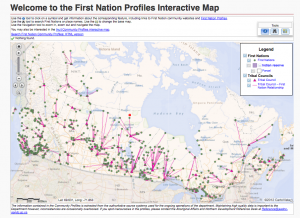
To help myself answer this question, I first wanted to get a better understanding of how many different First Nations communities there are in Canada. On the Government Of Canada Website, is a First Nations Profiles Interactive Map which gives viewers a geographical visual of the various First Nations communities across Canada. The map also shows the tribal councils attached to the communities, and when zoomed in, the area of each of the reservations can be viewed. A link to the Inuit Community Profiles Interactive Map can also be accessed, as well, links to websites of the various First Nations communities are listed to determine services available within the communities. What is not listed on the map is what various languages are spoken within the communities, nor is the population of the communities. This information would be helpful for example, to develop a better understanding of the amount of supplies needed for the community members if they are in remote or isolated communities.
Educating Myself
Two websites I found to give me an overview of issues include:
- The Centre of Social Justice cites general social issues endured by First Nations communities.
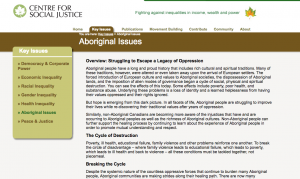 Although the statistics are nearly 20 years outdated, the issues are well outlined and a good starting point for research. Of the issues mentioned include: poverty/inequality, lack of access to health care, unemployment barriers, lack of sensitivity and inclusiveness in the education system, and the restriction of civil and political rights.
Although the statistics are nearly 20 years outdated, the issues are well outlined and a good starting point for research. Of the issues mentioned include: poverty/inequality, lack of access to health care, unemployment barriers, lack of sensitivity and inclusiveness in the education system, and the restriction of civil and political rights.
2. Aboriginal Issues in Canada is a Western University project, created i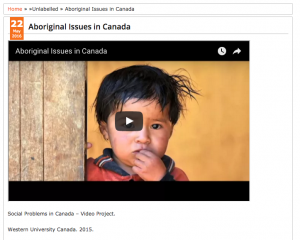 n 2015. It is a slideshare video posted on Canada News which acknowledges the various issues that Canadian First Nations communities are confronted with. This video would be a great resource to show students as an introduction to the Aboriginal issues. It is not long, and the statistics are current.
n 2015. It is a slideshare video posted on Canada News which acknowledges the various issues that Canadian First Nations communities are confronted with. This video would be a great resource to show students as an introduction to the Aboriginal issues. It is not long, and the statistics are current.
Canada News has many archived videos on Aboriginal issues.
A Deafening Silence on Aboriginal Issues 
is an article written by Nancy Macdonald, and published in Macleans magazine September 30, 2015. The article reviews issues such as violent victimization, suicide, and missing women. Of particular interest to me was the discussion of Government involvement. This article was written in the brink of the National election and the article quotes the promises of Canada’s political parties to dedicate finances and resources to help Indigenous peoples. Bellegarde is directly quoted in the article, mentioning the $110 million that has been spent in court battles on First Peoples rights. Wouldn’t this money be better spent on solving the problems? Change, according to Murray Sinclair, will not happen overnight, but occur “in neighbourhood by neighbourhood, street by street, and family by family.”
First Peoples Potable Water Issue
Of particular interest to me is the issue of access to potable water within the various First Peoples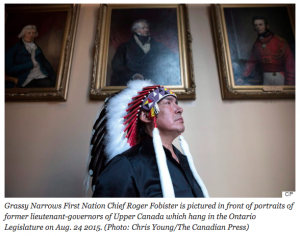 communities. An article written in the Huff Post on March 9, 2016 by Jessica Chin, titled Canada First Nations Water Issue To Be Fixed: UN, discusses the issue, statistics and politics around access to potable water. Chin cites the United Nations calling upon Prime Minster Trudeau to address the issue because of Human Rights and cultural concerns. Not having all weather roads is a factor contributing to not have access to water. However, access to fresh drinking water is not a problem only to remote or isolated communities but also to those who live on reservations in the lower mainland. The Semiahmoo Nation for example, has become vocal in local media asking for help to solve their water concern. An article can be found here. A summative report written by David R. Boyd, Ph.D., J.D, titled, No Taps, No Toilets: First Nations and the Constitutional Right to Water in Canada contends that the rights of particular Nations from Quebec, Ontario, Manitoba and Alberta “are being violated by the government’s failure to provide safe drinking water, an essential service which is vital to life, health, and human dignity.” Therefore, it will be interesting to see within the next few years how the government plans to take action in correcting his human rights concern.
communities. An article written in the Huff Post on March 9, 2016 by Jessica Chin, titled Canada First Nations Water Issue To Be Fixed: UN, discusses the issue, statistics and politics around access to potable water. Chin cites the United Nations calling upon Prime Minster Trudeau to address the issue because of Human Rights and cultural concerns. Not having all weather roads is a factor contributing to not have access to water. However, access to fresh drinking water is not a problem only to remote or isolated communities but also to those who live on reservations in the lower mainland. The Semiahmoo Nation for example, has become vocal in local media asking for help to solve their water concern. An article can be found here. A summative report written by David R. Boyd, Ph.D., J.D, titled, No Taps, No Toilets: First Nations and the Constitutional Right to Water in Canada contends that the rights of particular Nations from Quebec, Ontario, Manitoba and Alberta “are being violated by the government’s failure to provide safe drinking water, an essential service which is vital to life, health, and human dignity.” Therefore, it will be interesting to see within the next few years how the government plans to take action in correcting his human rights concern.
